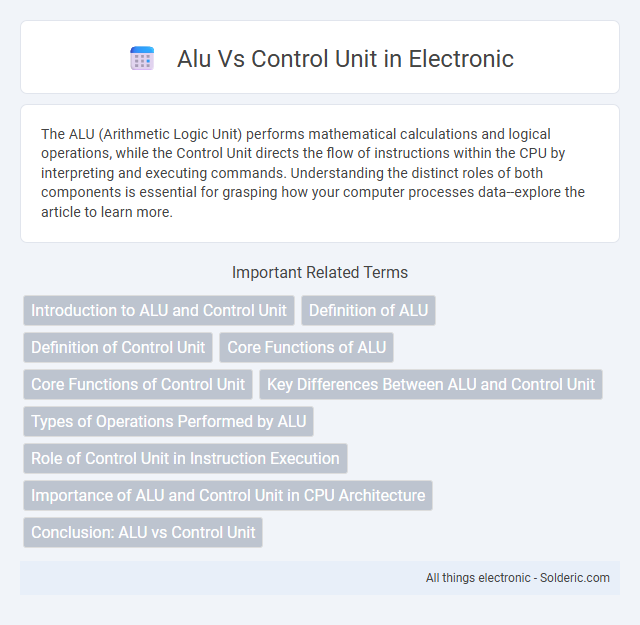The ALU (Arithmetic Logic Unit) performs mathematical calculations and logical operations, while the Control Unit directs the flow of instructions within the CPU by interpreting and executing commands. Understanding the distinct roles of both components is essential for grasping how your computer processes data--explore the article to learn more.
Comparison Table
| Feature | Arithmetic Logic Unit (ALU) | Control Unit (CU) |
|---|---|---|
| Function | Performs arithmetic and logical operations | Directs the operation of the processor by controlling signals |
| Role in CPU | Executes instructions related to calculations and logic | Manages and coordinates instruction execution |
| Operations | Addition, subtraction, AND, OR, NOT, comparison | Instruction decoding, control signal generation |
| Components | Operands, arithmetic circuits, logic gates | Decoder, timing circuits, control signal circuits |
| Output | Result of arithmetic or logical operation | Control signals to other CPU units |
| Interaction | Receives data from registers and memory | Fetches and decodes instructions, sends commands |
| Importance | Central for data processing tasks | Essential for coordinating CPU activities |
Introduction to ALU and Control Unit
The Arithmetic Logic Unit (ALU) performs all arithmetic and logical operations essential for processing data within a computer system. The Control Unit directs the flow of data by interpreting instructions from the program and managing the execution sequence. Understanding the distinct roles of the ALU and Control Unit helps optimize your system's overall computational efficiency.
Definition of ALU
The Arithmetic Logic Unit (ALU) is a critical component of the CPU responsible for performing arithmetic and logical operations, such as addition, subtraction, and bitwise logic calculations. Unlike the control unit, which directs the execution of instructions and manages data flow within the processor, the ALU executes the actual computation tasks. Your computer's processing speed and efficiency heavily depend on the ALU's performance in handling these fundamental operations.
Definition of Control Unit
The Control Unit (CU) is a fundamental component of the central processing unit (CPU) responsible for directing the operation of the processor by interpreting instructions from the program and generating control signals for other components. It manages the execution of instructions by coordinating data flow between the Arithmetic Logic Unit (ALU), registers, and memory, ensuring sequential operation of the CPU. Unlike the ALU, which performs arithmetic and logical operations, the Control Unit focuses on instruction decoding, timing, and control signal distribution.
Core Functions of ALU
The Arithmetic Logic Unit (ALU) performs essential core functions including executing arithmetic operations like addition, subtraction, multiplication, and division, as well as logical operations such as AND, OR, NOT, and XOR. It processes binary data inputs from registers, producing results that facilitate decision-making and computations within the CPU. The ALU's efficiency in handling these operations directly impacts the overall processing speed and performance of a computer system.
Core Functions of Control Unit
The control unit manages the execution of instructions by directing the operation of the ALU, memory, and input/output devices, ensuring synchronized data flow within the CPU. It interprets instruction codes and generates necessary control signals to coordinate the arithmetic and logic operations performed by the ALU. Your computer's overall processing efficiency relies on the control unit's ability to orchestrate these fundamental tasks accurately.
Key Differences Between ALU and Control Unit
The ALU (Arithmetic Logic Unit) performs all arithmetic and logical operations such as addition, subtraction, AND, and OR, directly manipulating data based on instructions. The Control Unit directs the operation of the processor by interpreting instructions and generating control signals to coordinate the activities of the ALU, memory, and input/output devices. Your understanding of computer architecture improves by recognizing that the ALU handles data processing while the Control Unit manages instruction flow and execution.
Types of Operations Performed by ALU
The Arithmetic Logic Unit (ALU) performs fundamental operations including arithmetic calculations like addition, subtraction, multiplication, and division, as well as logical operations such as AND, OR, XOR, and NOT. It processes bitwise operations, shift operations, and comparison operations that determine equality or magnitude between binary values. Unlike the Control Unit, which manages instruction sequencing and execution flow, the ALU directly manipulates data to produce computational results.
Role of Control Unit in Instruction Execution
The Control Unit orchestrates the execution of instructions by directing the flow of data between the ALU, memory, and registers, ensuring each instruction is processed correctly. It interprets the instruction opcode and generates control signals to activate the ALU operations, manage read/write actions, and control program sequencing. Your processor relies on the Control Unit to coordinate these activities, enabling efficient and accurate instruction execution.
Importance of ALU and Control Unit in CPU Architecture
The Arithmetic Logic Unit (ALU) performs essential mathematical and logical operations critical for data processing within the CPU, directly affecting your computer's performance and efficiency. The Control Unit orchestrates the execution of instructions by directing data flow between the ALU, registers, and memory, ensuring accurate and synchronized processing. Both units are integral to CPU architecture, enabling seamless operation and execution of complex computing tasks.
Conclusion: ALU vs Control Unit
The ALU (Arithmetic Logic Unit) executes arithmetic and logical operations essential for data processing, while the Control Unit manages instruction sequencing and coordinates the activities of the CPU components. Your system's overall performance depends heavily on effective collaboration between the ALU's fast computation and the Control Unit's precise command execution. Both units are integral, with the ALU focusing on data manipulation and the Control Unit on operation flow control, making them equally critical in computer architecture.
alu vs control unit Infographic

 solderic.com
solderic.com